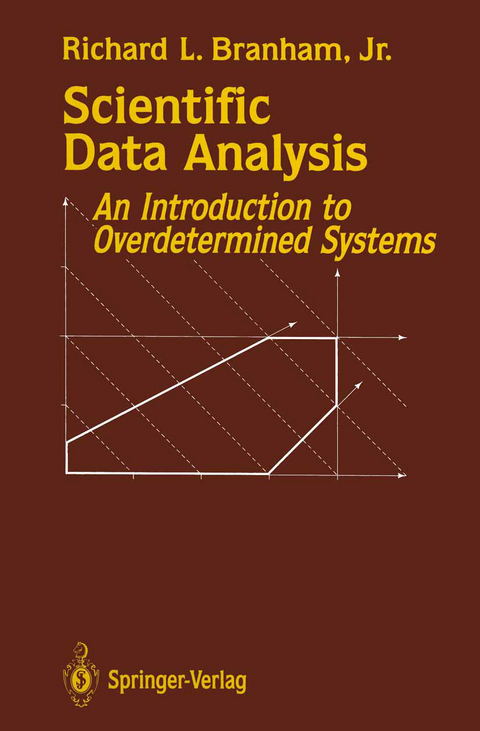
Scientific Data Analysis
Springer-Verlag New York Inc.
978-1-4612-7981-5 (ISBN)
This monograph is concerned with overdetermined systems, inconsistent systems with more equations than unknowns, in scientific data reduction. It is not a text on statistics, numerical methods, or matrix cOmputations, although elements of all three, especially the latter, enter into the discussion. The reader I have in mind is a scientist or engineer who has gathered data that he or she wants to model by a mathematical system, perhaps linear, perhaps nonlinear, and solve to obtain the best estimates, in some sense of the term "best," of various parameters. Because the calculations will be performed on a digital computer, the first chapter discusses floating-point numbers and their effect on mathematical operations. The chapter ends with some methods for accurately summing floating-point numbers, an operation frequently required in numerical work and one often done by the worst possible method, recursive summation. Chapter 2 gives a brief review of linear algebra and includes vector and matrix norms and condition numbers of matrices and linear systems. ' Chapter 3 presents some ideas for manipulating sparse matrices. Frequently, time or memory can be saved by use of sparse matrix techniques. The subject is extensive and the chapter is only indicative of the many techniques available. Although Chapter 3 is somewhat extraneous to the rest of the book, Chapter 5, on linear least squares, makes use of the compressed storage mode for the symmetric matrices discussed in Chapter 3.
1 Properties of Floating-Point Numbers.- 1.1. Introduction.- 1.2. Representation of Floating-Point Numbers.- 1.3. Characteristics of Floating-Point Numbers.- 1.4. Violation of the Laws of Arithmetic.- 1.5. Accurate Floating-Point Summation.- 2 Matrices, Norms, and Condition Numbers.- 2.1. Matrices.- 2.2. Vector and Matrix Norms.- 2.3. The Condition Number.- 3 Sparse Matrices.- 3.1. Introduction.- 3.2. Sparse Techniques for Null Elements Following a Pattern.- 3.3. Sparse Techniques with Null Elements in Random Locations.- 3.3.1. The Bit Map.- 3.3.2. Paired Vectors.- 3.3.3. The Linked List.- 3.3.4. Hashing.- 3.4. Conclusions.- 4 Introduction to Overdetermined Systems.- 4.1. Introduction.- 4.2. Mathematical Theory of Overdetermined Systems.- 4.3. Modeling Errors and Outliers.- 4.4. Solution of Linear Systems.- 5 Linear Least Squares.- 5.1. The Normal Equations.- 5.2. Solution of the Normal Equations.- 5.3. The Variance-Covariance and Correlation Matrices.- 5.4. Orthogonal Transformations.- 5.5. Iteratively Reweighted Least Squares.- 5.6. Constrained Least Squares.- 6 The L1 Method.- 6.1. Introduction.- 6.2. General Considerations of the Li Solution.- 6.3. Linear Programming.- 6.4. The L1 Algorithm and Error Estimates.- 7 Nonlinear Methods.- 7.1. Introduction.- 7.2. Gradient Methods.- 7.3. Nongradient Methods.- 8 The Singular Value Decomposition.- 8.1. Introduction.- 8.2. Calculating the SVD.- 8.3. Total Least Squares.- 8.4. Singular Value Analysis.
| Zusatzinfo | X, 237 p. |
|---|---|
| Verlagsort | New York, NY |
| Sprache | englisch |
| Maße | 155 x 235 mm |
| Themenwelt | Mathematik / Informatik ► Informatik ► Datenbanken |
| Informatik ► Theorie / Studium ► Algorithmen | |
| Mathematik / Informatik ► Mathematik ► Wahrscheinlichkeit / Kombinatorik | |
| ISBN-10 | 1-4612-7981-X / 146127981X |
| ISBN-13 | 978-1-4612-7981-5 / 9781461279815 |
| Zustand | Neuware |
| Informationen gemäß Produktsicherheitsverordnung (GPSR) | |
| Haben Sie eine Frage zum Produkt? |
aus dem Bereich


